I have been admiring photos of late-summer flowers and harvests on blogs from the northern hemisphere, a far cry from our abnormally hot and dry spring. As respite from our drought here in South Africa, I dug out some old family photographs of country living in English villages in the first half of the 20th century.
My mother, her parents, and generations of their ancestors grew up in villages in Herefordshire and Gloucestershire. Despite two world wars – in which brothers and uncles were killed or wounded (along with millions of others) – and the Great Depression in the 1930s, family life in the small villages continued. Surviving photographs record not only special occasions (weddings and birthdays) and beach holidays for the extended family in Cornwall, but also informal scenes at home and in the surrounding countryside that are redolent of a bygone era.
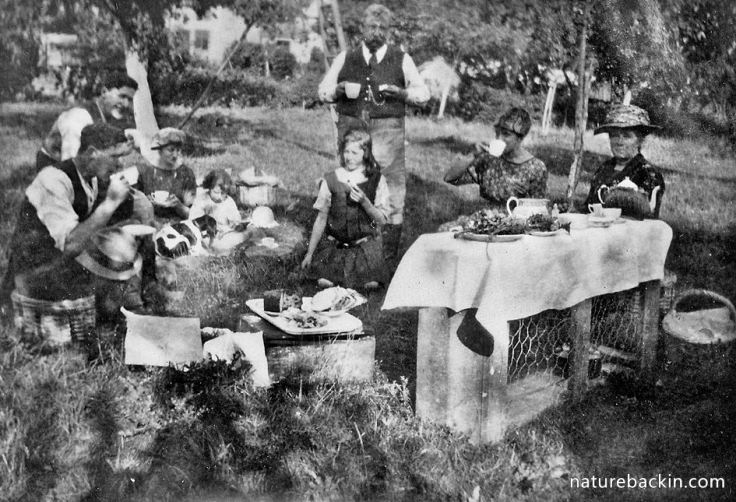
My mother was an only child, but her mother had six sisters and two brothers. In the photo above are some of the family taking tea in the orchard, perhaps while having a rest from picking fruit
In the orchard adjoining their home in the village of Longhope in Gloucestershire, were damson and apple trees. Damsons were harvested to be used to make preserves and jam. There was a central jam factory in the village, and in season, jam was the major export of the village.
Wikipedia has an interesting discussion on damsons and the distinction between the smaller fruited English varieties and the those known as “damascenes”. Some studies show that the English damsons developed from wild sloes and do not have cherry plums in their heritage. There are many varieties of English damson, for example, the Gloucestershire Orchards Trust lists 17 varieties of plums and damsons. Including, divertingly enough, a small greenish damson from the Chaxhill and Longhope areas known as Shit Smock, named for what happens when one eats too many.

The family in Longhope gathered in the orchard with baskets of freshly harvested damsons
Several factors led to the decline of damson-growing and jam-making practices in England, including the rationing of sugar during and after the Second World War and the relatively high cost of British-grown fruit. Interest in heritage species such as damsons has shown a recent rekindling, and nurseries do stock and sell a number of varieties. Some damsons have become naturalised not only in England, but also in North America, where damsons were introduced by early settlers. Wild-growing damsons provide fruits for foragers that include humans.
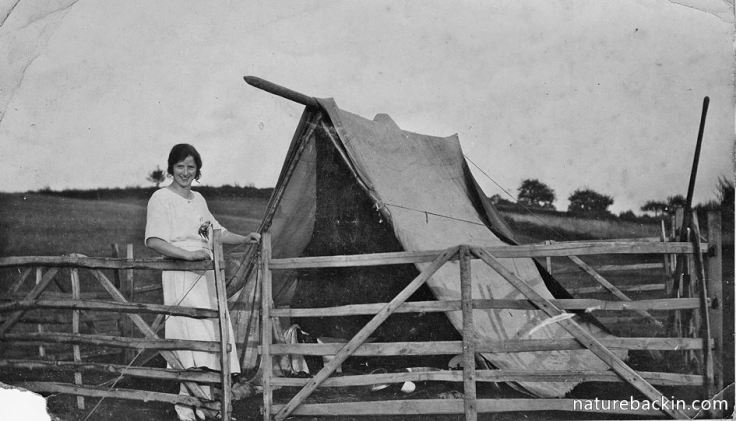
I have always been intrigued by this photo of my gran, looking very happy and relaxed, next to a relatively makeshift tent in fenced-in a section of a field. I have not been able to find out from others in the family about the reason for such a camping escapade

A rather fuzzy photo, but charmingly showing one of my great aunts with two fellas in a punt. The photo was taken by one of her sisters. Note the swan at the back reflected in the water near the bank
My grandmother’s father owned the local butchery. In addition to the orchard, they kept sheep on a couple of meadow fields and they also kept horses to pull the trap and a cart. My great-grandfather loved attending the races in Gloucester with betting providing as much interest as the horses themselves. Family lore has it that he lost ownership one of the meadows as he had to use it to pay off a huge debt from a bad bet.
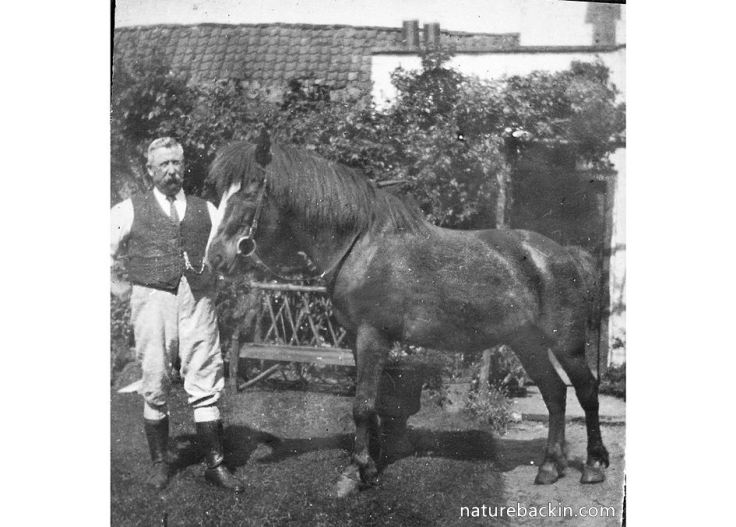
Here he is with a horse in the garden of their house in Longhope

Going further back in time, this is a picture of my gran’s mother’s parents, also in Longhope
As in most families in small villages, my grandmother and her sisters contributed to running and maintaining the household, although to my grandmother’s ongoing regret, when she was quite small she got “farmed out” for a few years to live with her mother’s childless sister and her husband in Leominster.

My grandmother and one of her sisters attending to the washing in the garden

The aunt with whom my grandmother stayed, in her kitchen garden behind their large house just outside Leominster. The house is still standing, gracing what is now an organic kale farm

My grandmother’s uncle, a well-known townsman and breeder of Hereford cattle, in front of a hay wagon on their farm just outside Leominster
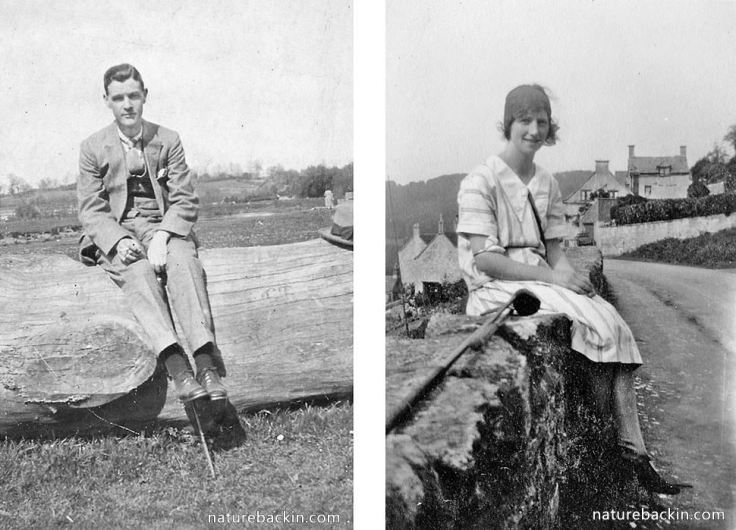
My grandfather taking a rest while on a country walk and my gran seated on a stone wall in the village. I guess that the golf club belonged to my grandfather but perhaps she also played golf in her youth
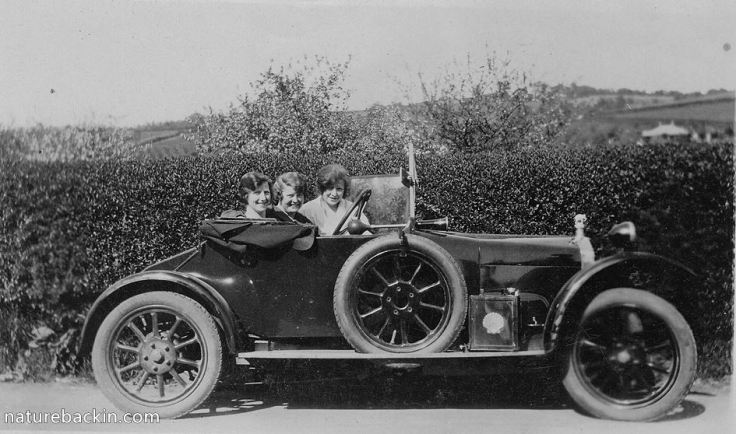
My gran at the wheel, with two of her sisters in the family car. I have not been able to find out the make of the car. I love the petrol tank on the running board and the tiny elephant mascot on the bonnet
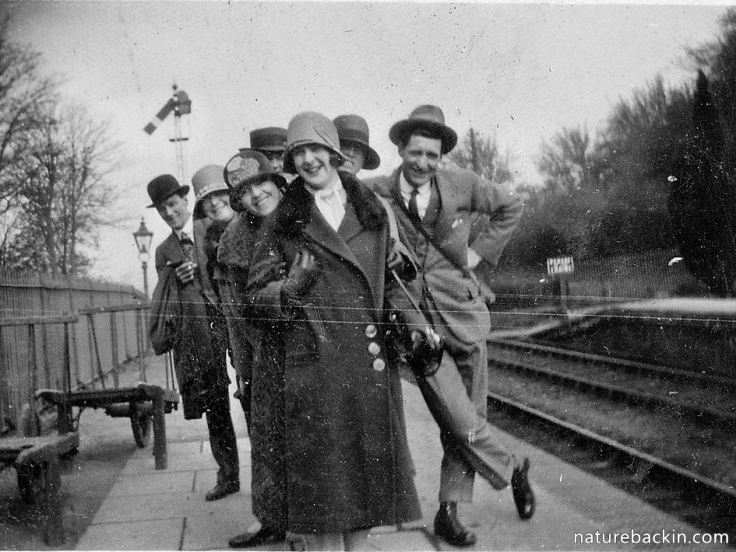
Without a car there was always the train. Here some of my great aunts, great uncles and friends are playing it up for the camera
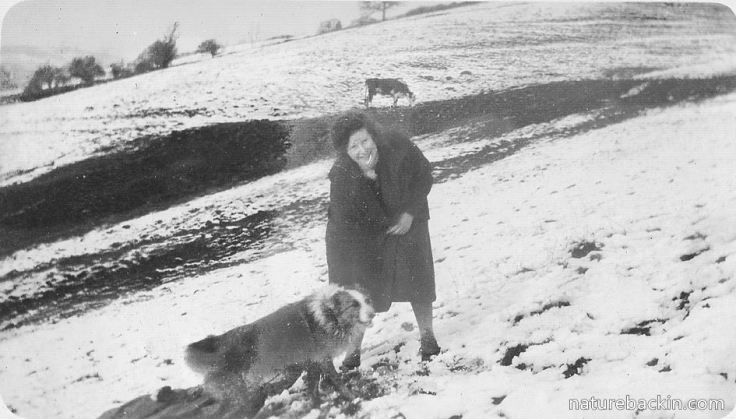
Snow on the slopes above the village and one of my gran’s sisters with the family dog. My mother tells me that the dog was always a collie and, as one succeeded another, the males were all named Bob and the females were all named Nell
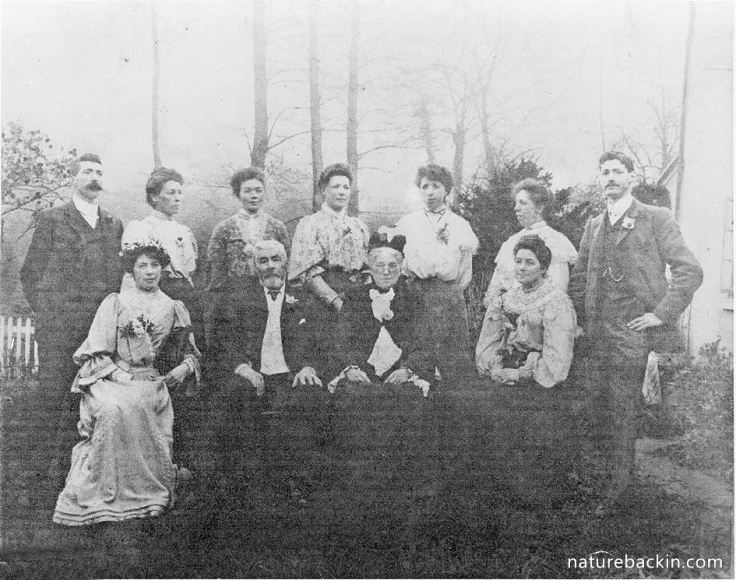
And to end off, a formal photograph of my great-great-grandparents with their children and other relatives. This does not appear to be a studio shot, and the formality is softened by the garden and it is made a little mysterious by the bare trees forming the backdrop
And as a footnote, back in contemporary times and our drought: after two exhaustingly scorching days of temperatures in the region of 40 degrees C, today it is overcast and in the low 20s, and we have even had the very lightest sprinkling of rain, which is thickening slightly as I write this!
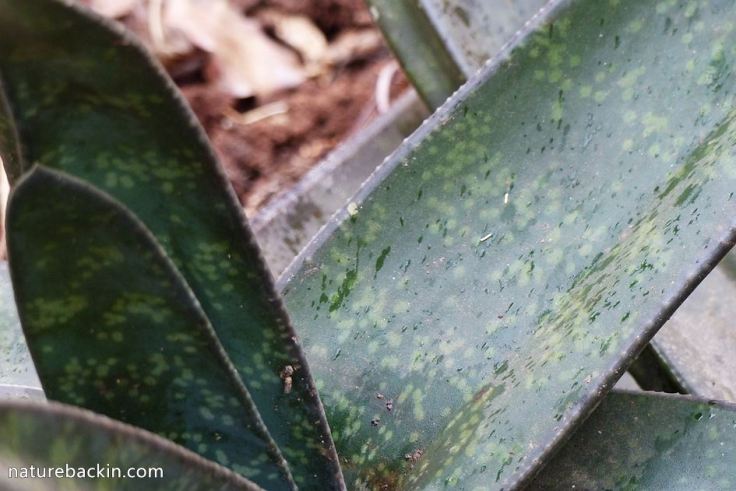
Small raindrops marking the dusty leaves of a gasteria in our garden this morning
Sources:
Damson. Wikipedia. https://en.wikipedia.org/wiki/Damson#CITEREFWoldring1998
Gloucestershire Orchards Trust. Plums. https://en.wikipedia.org/wiki/Damson#CITEREFWoldring1998
Longhope Village Website. http://www.longhopevillage.co.uk/
Posted by Carol

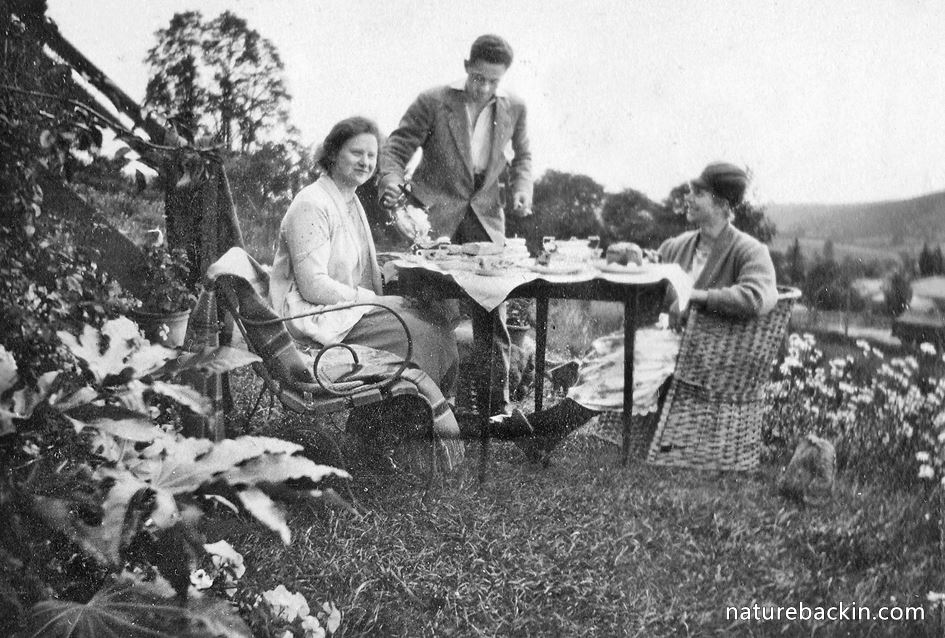







May 31, 2019 at 2:32 pm
Fabulous photos! What a collection. 🙂 One of them – your great aunt in her kitchen garden – is reminiscent of a vintage photo I have with a very similar garden path and people posing for the camera, sitting on the path. I collect vintage photos (and post about them in a different blog) and have loads of my own family’s ones, too.
I also love nature, so shall follow your blog and hope to read more. 🙂
LikeLiked by 1 person
June 1, 2019 at 12:51 pm
Thank you Val – how nice to share a fondness for old family photos (I like all sorts of family and domestic memorabilia) and a love of nature. I have had a quick peek at your blog and will be back when I have more time.
LikeLiked by 1 person
October 17, 2018 at 5:17 am
I just love old family photos and yours are most interesting with the orchards and backgrounds. Most of my own are mostly portraits (although there are a few in the large garden on the family farm).
LikeLiked by 1 person
October 17, 2018 at 11:32 am
I also love old photos. Often the incidental background details are the most fascinating part, although portraits are usually studio shots, but it is so interesting to see how people presented themselves to the camera.
LikeLike
September 19, 2017 at 6:01 pm
This is a special post of reminisensce. Being from French roots in the lavender rich Provence area of France our ancestors probably wasn’t the best of friends 🙂
However there is a strange twist to this.When my mother was a child her parents had a farm called Longhope (close to Mosselbay). Now I wonder where that name derived from…
LikeLiked by 1 person
September 19, 2017 at 6:54 pm
That is amazing re the name Longhope! I wonder if perhaps there is a connection to the English village? Btw, on my dad’s side I also have Huguenot ancestors – along with Dutch and German and Scots too! Tangled roots …
LikeLiked by 1 person
September 19, 2017 at 7:05 pm
Co-incidentally we are visiting my aunt in Oudtshoorn this weekend – if I remember I will ask her
LikeLiked by 1 person
September 19, 2017 at 7:20 pm
Have safe travels and enjoy your stay in Oudtshoorn.
LikeLiked by 1 person
September 19, 2017 at 7:30 pm
Thanks I will try to disturb the weather patterns so we can have rain…
LikeLiked by 1 person
September 19, 2017 at 7:47 pm
🙂 Thanks – we need all the help we can get!
LikeLiked by 1 person
September 18, 2017 at 1:20 pm
I so enjoyed all of your old family photos!
LikeLiked by 1 person
September 19, 2017 at 5:42 am
Thanks. Glad you enjoyed them.
LikeLike
September 17, 2017 at 12:21 pm
I love these photos. They tell such beautiful stories.
LikeLiked by 1 person
September 17, 2017 at 7:06 pm
Thanks Dawn.I am glad that you also find these photos so evocative 🙂
LikeLike
September 16, 2017 at 12:29 pm
Wonderful read, and the photographs are absolute treasures. Damsons are particularly evocative for me. Damsons and greengages are meshed in my childhood and are rarely seen today. How special to have this history of your family, Carole. Thank you for sharing with us.
LikeLiked by 1 person
September 17, 2017 at 6:29 am
Thanks Sandra. Lovely that the damsons evoke memories for you too. Sad how much that was formerly so everyday has now slipped away, but things change … it is fortunate to have photos recording aspects of ordinary life that are no more.
LikeLiked by 1 person
September 15, 2017 at 6:06 am
What a MARVELLOUS read!
LikeLiked by 1 person
September 15, 2017 at 6:48 am
Thank you very much Anne. I did enjoy assembling the photos.
LikeLike
September 15, 2017 at 5:46 am
Delightful. Interesting that we both post about our ancestors this week. Looks like you had a whole lot of lovely Aunts – lucky you! Enjoy the mizzle.
LikeLiked by 1 person
September 15, 2017 at 6:47 am
Thanks Nikki. It is a coincidence, I thought it would be more about country life, but the great aunts have a way of taking centre stage. Pity in a way to live in another country to such a busy family. In South Africa I have a very small family. Parts of the family were estranged and there was one childless aunt and I have not a single cousin.
LikeLike
September 15, 2017 at 2:17 am
Thanks for taking us back in time with you!
LikeLiked by 1 person
September 15, 2017 at 6:41 am
Thanks so much! For me too, it felt like a bit of journey through time and space choosing the photos.
LikeLiked by 1 person
September 14, 2017 at 11:51 pm
Excellent post!
LikeLiked by 1 person
September 15, 2017 at 6:39 am
Thanks Belinda. So glad you like it – I felt a bit nervous about sharing images of family life.
LikeLiked by 1 person
September 15, 2017 at 10:34 am
They complemented your writing wonderfully.
LikeLiked by 1 person
September 14, 2017 at 9:54 pm
Such a treasure trove of old family photos you have, Carol. It makes that time come alive when you share a history.
Hope you get a good rain for your garden!
LikeLiked by 1 person
September 15, 2017 at 6:37 am
Thanks Eliza. Yes the old photos are treasures. Many of the prints are tiny, so it is amazing that they have scanned as well as the have.
Thanks for your good wishes for rain. We have excellent news – we had a lovely gentle 6 mls over the past 24 hours, and it is overcast this morning giving the rain a chance to soak in. Such a relief after the intense dry heat 🙂
LikeLiked by 1 person
September 15, 2017 at 1:55 pm
Yay!
LikeLiked by 1 person
September 15, 2017 at 6:51 pm
Definitely yay! And it is raining again this evening 🙂
LikeLiked by 1 person
September 14, 2017 at 9:14 pm
I think this might well be the car!
Or at least the same make . Check the detail on the spokes of the spare wheel.
LikeLiked by 1 person
September 15, 2017 at 6:34 am
Thanks so much Ark. I am so pleased to discover that it is one of the Sunbeams. Probably a model from the 1920s. What a lovely car,
LikeLiked by 1 person
September 15, 2017 at 11:20 am
All Hail Google … bows down in worship!
I like a challenge and cars. So.
the hunt was on.
My Grandfather once owned a taxi service and ran a small fleet of Packards!
My dad took his driving test in one and crashed it!
LikeLiked by 1 person
September 15, 2017 at 6:50 pm
I don’t know enough about cars to Google successfully based on what was in the photograph, and the elephant mascot was a red herring so to speak, as I only recently found out that not all mascots come with the car. Thanks for taking on the challenge and coming up with the answer.
Your poor dad did not have an auspicious start to his driving career! I should think that your grandfather was a tad peeved.
LikeLike
September 14, 2017 at 9:02 pm
How marvelous!
I concur with Tish and the photo of your granny.
My father’s side of the family all hail from Cornwall. Dad was born in Newquay. Mum comes from Royston in Hertfordshire and she used to make damson jam when we lived in Chester.
I remember the top shelves in the pantry lined with jars full of damson jam!
I must ask my folks if they have any really old photos of this era.
Dad has scanned and sent a few of me as a baby, so I guess there must be some older ones around somewhere.
A lovely post.
LikeLiked by 1 person
September 15, 2017 at 6:31 am
Thanks so much Ark. I am delighted that you like the post. I am a sucker for old photos of everyday life. A coincidence that your Dad comes from Newquay as that is exactly where my grandmother and her sisters and brothers-in-law spent their holidays together. They liked it so much that my grandparents even named their house after one of the beaches! I like the mental image of the pantry shelves lined with your mum’s homemade damson jam. I have never been fortunate enough to sample any damson jam. I do hope that your parents unearth some more old photos to share with you.
LikeLike
September 15, 2017 at 11:28 am
There were a couple of summers they went fruit picking. I might have trouble eating a Jam Sarmie these days!
Maybe your grandparents and my dad met one summer? As a kid my dad used to practically live on the beach and would ”Sling Deckchairs” for tourists during summer hols for pocket money before he was old enough to join the RAF.
You never know? Stranger things have happened!
I will most definitely ask dad to dig out some old photos. It’ll be fun.
LikeLiked by 1 person
September 15, 2017 at 7:06 pm
I agree about the jam sarmie!
Perhaps they did meet on the beach – I gather that Tolcarne beach was where my lot mostly hung out. Maybe I should do a post featuring the family holiday snaps! My grandfather was also in the RAF, up in the airships in WW1 when he was very young, and in air traffic control in WW2. Hope your dad does come up with some old photos.
LikeLike
September 14, 2017 at 8:44 pm
A wonderful trip back in time. You are fortunate to have so many pictures depicting the
daily life of your family in a bygone era.
LikeLiked by 1 person
September 15, 2017 at 6:25 am
Thanks Sandy. Yes it is amazing that the family recorded so much on camera and that so many photos have survived. One of the benefits of being in a family of hoarders!
LikeLiked by 1 person
September 14, 2017 at 8:11 pm
What absolute treasures of photos, Carol, and some of them taken not too far from Wenlock either. The shot of your gran, so elegantly turned out for tent living, is priceless in all senses.
LikeLiked by 1 person
September 15, 2017 at 6:22 am
Thanks Tish. I have just looked up Wenlock on the map and see it is a bit north of Leominster. Yes that shot of my gran is a favourite of mine. It is a nice clear pic and she looks so happy. I knew her as constantly busy and quite tense, so it is lovely to see her looking so relaxed, and the camp setup is a real puzzle.
LikeLiked by 1 person
September 14, 2017 at 8:09 pm
A really fascinating post which I shall read properly later. Equally interesting is the stuff about damsons. My feeling is they seem to be bigger and sweeter than they used to be. For me, damsons should have a distinctive tartness. Or is that just me?
LikeLiked by 1 person
September 15, 2017 at 6:07 am
How amazing to make time for blogging while you are travelling 🙂 Thanks Margaret. Perhaps fashions have changed to favour the sweeter varieties of damsons? Btw, along the lines of your post on mulberry gin, I read that there is a small tradition in making damson gin too.
LikeLike